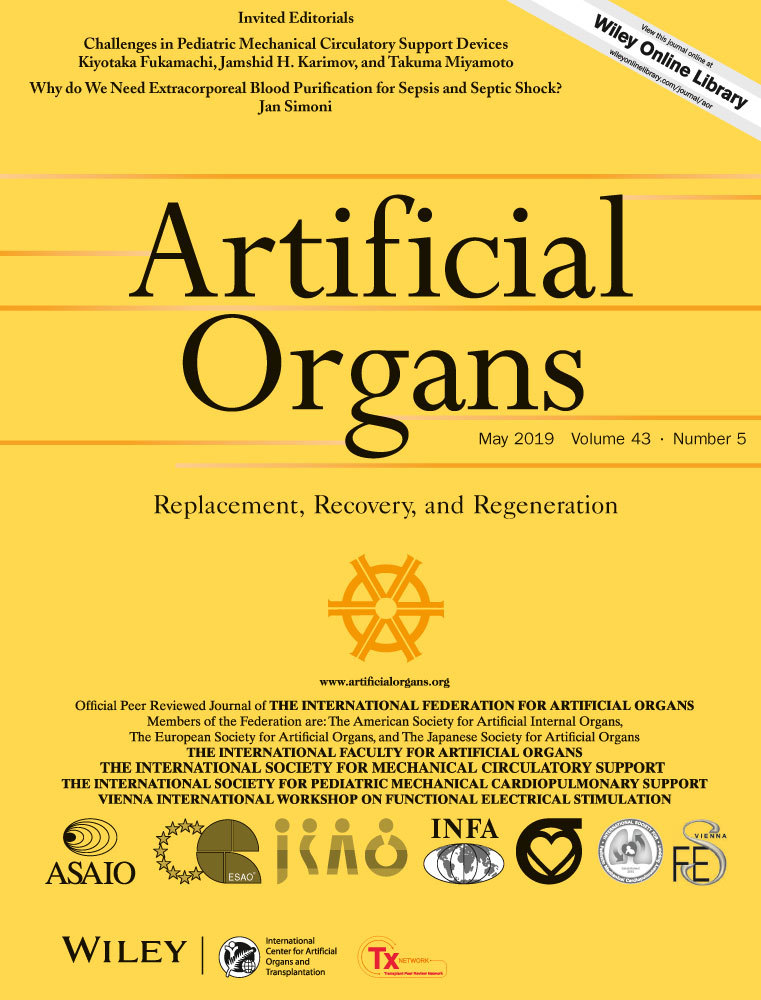Challenges in pediatric mechanical circulatory support devices
Corresponding Author
Kiyotaka Fukamachi
Department of Biomedical Engineering, Lerner Research Institute, Cleveland Clinic, Cleveland, Ohio
Correspondence
Kiyotaka Fukamachi, Department of Biomedical Engineering/ND20, Cleveland Clinic, 9500 Euclid Avenue, Cleveland, OH 44195, USA.
Email: [email protected]
Search for more papers by this authorJamshid H. Karimov
Department of Biomedical Engineering, Lerner Research Institute, Cleveland Clinic, Cleveland, Ohio
Search for more papers by this authorTakuma Miyamoto
Department of Biomedical Engineering, Lerner Research Institute, Cleveland Clinic, Cleveland, Ohio
Search for more papers by this authorCorresponding Author
Kiyotaka Fukamachi
Department of Biomedical Engineering, Lerner Research Institute, Cleveland Clinic, Cleveland, Ohio
Correspondence
Kiyotaka Fukamachi, Department of Biomedical Engineering/ND20, Cleveland Clinic, 9500 Euclid Avenue, Cleveland, OH 44195, USA.
Email: [email protected]
Search for more papers by this authorJamshid H. Karimov
Department of Biomedical Engineering, Lerner Research Institute, Cleveland Clinic, Cleveland, Ohio
Search for more papers by this authorTakuma Miyamoto
Department of Biomedical Engineering, Lerner Research Institute, Cleveland Clinic, Cleveland, Ohio
Search for more papers by this author
REFERENCES
- 1Go AS, Mozaffarian D, Roger VL, Benjamin EJ, Berry JD, Blaha MJ, et al. Heart Association Statistics Committee, and Stroke Statistics Subcommittee. Executive summary: heart disease and stroke statistics–2014 update: a report from the American Heart Association. Circulation 2014; 129: 399–410.
- 2Moazami N, Hoercher KJ, Fukamachi K, et al. Mechanical circulatory support for heart failure: past, present and a look at the future. Expert Rev Med Devices. 2013; 10: 55–71.
- 3Mehra MR, Goldstein DJ, Uriel N, Cleveland JC Jr, Yuzefpolskaya M, Salerno C, et al. Two-year outcomes with a magnetically levitated cardiac pump in heart failure. N Engl J Med 2018; 378: 1386–95.
- 4Lund LH, Khush KK, Cherikh WS, Goldfarb S, Kucheryavaya AY, Levvey BJ, et al. The Registry of the International Society for Heart and Lung Transplantation: thirty-fourth Adult Heart Transplantation Report-2017; focus theme: allograft ischemic time. J Heart Lung Transplant 2017; 36: 1037–46.
- 5Sandica E, Blanz U, Mime LB, Schultz-Kaizler U, Kececioglu D, Haas N, et al. Long-term mechanical circulatory support in pediatric patients. Artif Organs 2016; 40: 225–32.
- 6Pac M, Kocabeyoglu SS, Kervan U, Sert DE, Koca S, Ece I, et al. Third generation ventricular assist device: mid-term outcomes of the HeartWare HVAD in pediatric patients. Artif Organs 2018; 42: 141–7.
- 7Owens WR, Bryant R 3rd, Dreyer WJ, Price JF, Morales DL. Initial clinical experience with the HeartMate II ventricular assist system in a pediatric institution. Artif Organs 2010; 34: 600–3.
- 8Lorts A, Villa C, Riggs KW, Broderick J, Morales D. First Use of HeartMate 3 in a Failing Fontan Circulation. Ann Thorac Surg 2018; 106: e233–4.
- 9Baldwin JT, Borovetz HS, Duncan BW, Gartner MJ, Jarvik RK, Weiss WJ. The national heart, lung, and blood institute pediatric circulatory support program: a summary of the 5-year experience. Circulation 2011; 123: 1233–40.
- 10Duncan BW, Fukamachi K, Noble LD Jr, Dudzinski DT, Flick CR, Fumoto H, et al. The PediPump: a versatile, implantable pediatric ventricular assist device–update IV. Artif Organs 2009; 33: 1005–8.
- 11Fumoto H, Shiose A, Flick CR, Noble LD, Dudzinski DT, Casas F, et al. Short-term in vivo performance of the Cleveland clinic PediPump left ventricular assist device. Artif Organs 2014; 38: 374–82.
- 12Baldwin JT, Adachi I, Teal J, Almond CA, Jaquiss RD, Massicotte MP, et al. Closing in on the PumpKIN Trial of the Jarvik 2015 ventricular assist device. Semin Thorac Cardiovasc Surg Pediatr Card Surg Annu 2017; 20: 9–15.
- 13Peng DM, Koehl DA, Cantor RS, McMillan KN, Barnes AP, McConnell PI, et al. Outcomes of children with congenital heart disease implanted with ventricular assist devices: analysis of the Pediatric Interagency Registry for Mechanical Circulatory Support (PediMACS). J Heart Lung Transplant 2018; 37: S159-S.
- 14Fukamachi K, Karimov JH, Byram NA, Sunagawa G, Dessoffy R, Miyamoto T, et al. Anatomical study of the Cleveland Clinic continuous-flow total artificial heart in adult and pediatric configurations. J Artif Organs 2018; 21: 383–6.
- 15Fukamachi K, Karimov JH, Horvath DJ, Sunagawa G, Byram NA, Kuban BD, et al. Initial in vitro testing of a paediatric continuous-flow total artificial heart. Interact Cardiovasc Thorac Surg 2018; 26: 897–901.
- 16Karimov JH, Horvath DJ, Byram N, Sunagawa G, Kuban BD, Gao S, et al. Early in vivo experience with the pediatric continuous-flow total artificial heart. J Heart Lung Transplant 2018; 37: 1029–34.
- 17Chopski SG, Moskowitz WB, Stevens RM, Throckmorton AL. Mechanical circulatory support devices for pediatric patients with congenital heart disease. Artif Organs 2017; 41: E1–14.
- 18Steffen RJ, Miletic KG, Schraufnagel DP, Vargo PR, Fukamachi K, Stewart RD, et al. Mechanical circulatory support in pediatrics. Expert Rev Med Devices 2016; 13: 507–14.
- 19Izer JM, Wilson RP, Clark JB, Myers JL, Weiss WW, Undar A. Animal models for pediatric mechanical circulatory support research at Penn State Health. Artif Organs 2018; 42: 347–53.




